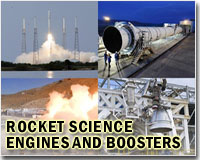 |
Orono ME (SPX) Apr 29, 2011 Five University of Maine students participated in a recent launch process as a rocket loaded with wireless sensors the students developed in a UMaine lab blasted off in California's Mojave Desert. The students, working under UMaine electrical and computer engineering Associate Professor Ali Abedi, collaborated on the NASA-funded project with faculty and student researchers at California State University at Long Beach and Garvey Spacecraft Corporation (GSC), a Long Beach, Calif.-based R and D company that focuses on cost-effective development of advanced space technologies and launch systems. The UMaine payload, which was integrated into a rocket known as the Prospector 18B, included sets of wireless sensors that detect acceleration in three dimensions to determine the amount of vibration of the rocket before and during liftoff. The vibration levels are crucial because even the most miniscule amount of vibration before launch could throw off a rocket from its intended path and reduce engine performance. The sensors sent back data to a laptop on the ground during the launch, and also stored data on board the payload when the sensors went out of range of the laptop. Abedi and his students will hand over their data to Cal State Long Beach, GSC and NASA so that those organizations can continue refining their models. The launch allowed the UMaine researchers real-world experimentation on the sensors. "This is an opportunity to test our wireless sensors on board a rocket in a harsh environment, at high altitudes, and to test the robustness and reliability of our wireless links," said Abedi, who runs UMaine's Wireless Sensor Networks Laboratory, known as the WiSe-Net Lab. "We knew theoretically it was going to work, but testing in the field is a different story." The launch took place on April 16 at the Friends of Amateur Rocketry test site in the Mojave Desert. The 27-foot, 500-pound Prospector 18B rocket, which was built in part by Cal State Long Beach students under the management and sponsorship of GSC, was launched and reached a height of nearly 2,100 feet before falling back to the earth on a 1,000 square foot parachute. The entire launch took about two minutes. The rocket came down a few hundred feet away from the launch site. The rocket had three payloads worth of UMaine's wireless sensor technology, each about the size of an adult's hand, on board in case one failed. UMaine's role in the project was funded by a $24,950 grant from NASA by way of the Maine Space Grant Consortium. In all, the project cost amounted to a little more than $80,000 with contributions from California Space Grant. "We're trying to show NASA that with a small amount of funding, you can do high-quality space experiments," Abedi said. "And it's a very good opportunity for the students at a low cost." Abedi also directed a group of UMaine students on a similar project in 2009. He is hoping to continue in the future. "The amount of excitement it creates for the students and the training opportunities they get is very interesting," Abedi said. "When the students build the wireless sensors in the lab, it works in the lab. Then they take it from the lab to the field, and they have to go through all the issues they would encounter in a real-world situation. They go there, stand on the field, integrate the sensors into the rocket, they need to take care of redundancy if anything goes wrong, that sort of thing." The students who worked on the project were seniors Zachary Janosik of Windham, Adam Marsano of Saco, John Murray of Raymond, and Joel Castro of Winslow. All four are electrical and computer engineering majors. Fred Schwaner of Hebron, who is pursuing a doctorate under Abedi and managed the project this year, participated as a UMaine undergraduate in 2009. The students trained to design wireless sensors for more than a year in order to be able to design and build payloads for this project, which took about two months. The short lead time was one of the reasons that the UMaine team chose to work with Cal State and GSC, as typical aerospace projects frequently require years before getting to flight. "It was pretty awesome. I'd never seen a rocket launch, and we were pretty close, 150-200 yards away," Janosik said. "It was a really amazing opportunity to do this and we're so glad the University of Maine offered this to us."
Share This Article With Planet Earth
Related Links University of Maine Rocket Science News at Space-Travel.Com
 Next-generation US space racers outline plans
Next-generation US space racers outline plansWashington (AFP) April 28, 2011 A handful of companies competing to make the spaceship to replace the iconic US shuttle said Thursday they are racing to shrink what will be a long gap in flying Americans into space aboard US craft. Boeing, SpaceX and Sierra Nevada Corporation were among the big winners of the latest round of US government funding, totaling 269.3 million dollars, through a NASA program to boost private comp ... read more |
|
| The content herein, unless otherwise known to be public domain, are Copyright 1995-2010 - SpaceDaily. AFP and UPI Wire Stories are copyright Agence France-Presse and United Press International. ESA Portal Reports are copyright European Space Agency. All NASA sourced material is public domain. Additional copyrights may apply in whole or part to other bona fide parties. Advertising does not imply endorsement,agreement or approval of any opinions, statements or information provided by SpaceDaily on any Web page published or hosted by SpaceDaily. Privacy Statement |